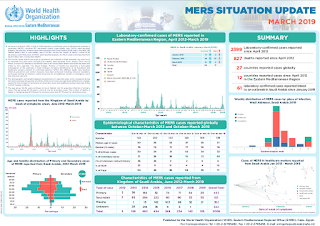#14,002
The pronounced uptick in MERS cases reported in the WHO's EMRO (Eastern Mediterranean Region) during the first quarter of 2019 - which I've highlighted in the WHO chart above - is the biggest in several years, and after slowing in March appears to be picking up again in April.
Details provided in the Saudi daily updates are scant, and so we rely on WHO GAR updates and summaries to fill in the gaps.The World Health Organization's Eastern Mediterranean Regional Office (EMRO) has published their latest (March 2019) MERS summary - and while very brief - it does provide us with a bit more insight into last month's MERS activity.
MERS situation update, March 2019
- At the end of March 2019, a total of 2399 laboratory-confirmed cases of Middle East respiratory syndrome (MERS), including 827 associated deaths (case–fatality rate: 34.4%) were reported globally; the majority of these cases were reported from Saudi Arabia (2008 cases, including 749 related deaths with a case–fatality rate of 37.3%). During the month of March, a total of 25 laboratory-confirmed cases of MERS were reported globally. All the 25 cases were reported from Saudi Arabia with 4 associated deaths.
- This month, Saudi Arabia continued to experience the outbreak in Wadi Aldwaser city and one of its hospitals as 9 new cases (including one death) were reported. From January 29 to end of March, a total of 61 laboratory-confirmed cases with 8 associated deaths have been reported and linked to this outbreak. The Saudi Arabian Ministry of health has launched a full-scaled investigation of the outbreak in Wadi Aldwasir including identification of all household and healthcare worker contacts of confirmed patients. Within the a ected health care facilities, infection prevention and control measures have been enhanced including intensive mandatory on-the-job training on infection control measures for all healthcare workers in emergency room and intensive care unit.
- The demographic and epidemiological characteristics of reported cases, when compared during the same corresponding period of 2013 to 2019, do not show any significant di erence or change, except for the increase in the number of secondary cases and healthcare worker cases due to the current hospital outbreak.
- The age group 50–59 years continues to be at highest risk for acquiring infection of primary cases. The age group 30–39 years is most at risk for secondary cases. The number of deaths is higher in the age group 50–59 years for primary cases and 70–79 years for secondary cases.
Read the latest MERS update, March 2019
With a cutoff date of March 31st, the 2019 total (according to the WHO) was 107. That differs from the number of cases reported through March 31st by the Saudis (n=114), likely due to delays in officially notifying the WHO.
Based on the daily reports (Epi weeks 1 - 15) - as of yesterday - Saudi Arabia has reported 130 MERS cases in 2019, and Oman has notified WHO of 13 cases.While we still aren't seeing sustained or efficient community transmission of the MERS virus - barring an unexpected slowdown in cases (or reporting) - it seems likely that Saudi Arabia will meet or exceed their 2018 MERS total sometime in April.


